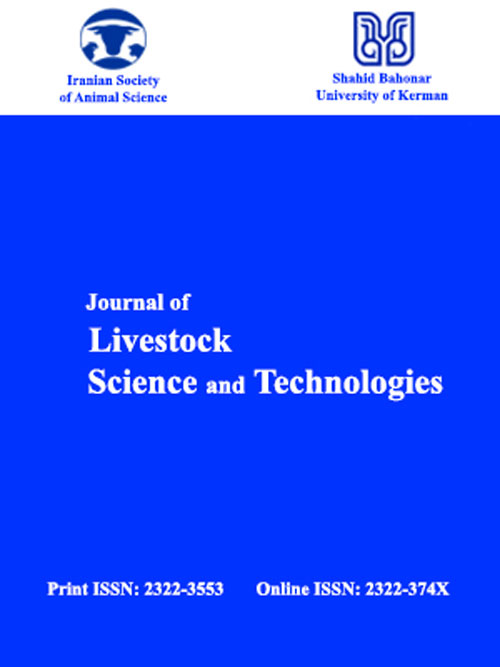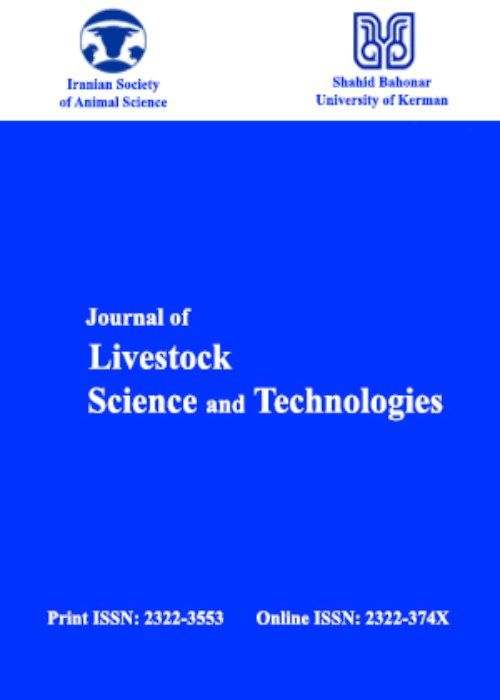فهرست مطالب

Journal of Livestock Science and Technology
Volume:10 Issue: 1, Jun 2022
- تاریخ انتشار: 1401/05/09
- تعداد عناوین: 7
-
-
Pages 1-9The objectives of this study were a) to compare growth functions for describing the early growth curve of Romane sheep based on weighing records, b) to estimate the heritability of the growth curve parameters, and c) to estimate genetic parameters for 90-days-old bodyweight utilizing the data of earlier age. The raw data included 662 lambs (316 males and 346 females) bred at the Romane Sheep Research Center, INRAE, France. The studied trait was the bodyweight of lambs at birth, 15, 21, 35, 60, and 90 days of age. The number of measurements was approximately six for each animal. Dataset after mining consisted of 3261 weight records of 574 lambs. We applied four non-linear growth functions, including Gompertz, Brody, Logistic, and Richard. The goodness of fit of the included models were compared using the Akaike information criterion (AIC), coefficient of determination (R2) and residual mean square (MSE). Predicting abilities of the included models were evaluated by comparing the predicted and observed phenotypes until 90 days of age. Genetic parameters of the non-linear functions were obtained using a specific two steps approach; in first step, the parameters of the different functions were estimated, and in the second, the parameters were considered as observations and we analyzed them using a multiple trait animal models. Residual mean square and R2 for the models of Brody, Gompertz, Logistic and Richards were 106.71 and 0.37, 4.79 and 0.94, 7.41 and 0.88, and 9.04 and 0.88, respectively. The Logistic function had the smallest AIC and MSE values, and also had the highest R2 value, indicating the best fit. The estimated heritability of the parameters in the logistic function were low (ranging from 0.007 to 0.017). In our study, the correlation between BV90 and BV35 was 0.5419 with a confidence interval of 0.469 - 0.608. Since BV90 and BV35 have a positive genetic correlation, BV35 could be used to select the lambs for best growth until the slaughter age of Romane using the Logistic modelKeywords: meat sheep, Growth curves, nonlinear model, genetic parameter, selection
-
Pages 11-18AbstractThe aim of this experiment was to study the effect of pure saponin and tannic acid on feed intake, weight gain, immune metabolites, blood lipids, and fatty acid profiles of lamb carcass. In this experiment, 18 lambs with an average weight of 17±1.5 kg were used in a completely randomized design (3 treatments with 6 replications) for 60 days. Treatments consisted of a basal diet consisting of forage (30%) and concentrates (70%), and diets containing saponin (150 mg/kg dry matter) or tannic acid (15 g/kg dry matter). Dry matter intake, weight gain, feed conversion ratio, packed cell volume and blood concentrations of hemoglobin, glucose, urea nitrogen, total proteins, and triglycerides were not affected by the experimental treatments. Concentration of saturated fatty acids and unsaturated fatty acids with a double bond did not show a significant difference between the experimental treatments, but the sum of unsaturated fatty acids with several double bonds was highest in the tannic acid treatment (P<0.05).Keywords: lamb, saponin, tannic acid, carcass composition
-
Pages 19-29This experiment was aimed at determining the chemical composition, fatty acid (FA) profile and degradability of American cockroach (Periplaneta americana) powder (ACP) in comparison with soybean meal (SBM), fish meal (FM), and poultry byproduct meal (PBM). The cockroaches were stored for 2h at -20 ºC, transferred to liquid nitrogen and subsequently grinded. Other samples were dried at 60 ˚C for 48 h. Experimental diets were: (1) control diet (only SBM), 2) diet containing 3% FM, 3) diet containing 3% ACP, and 4) diet containing 3% PBM. Two fistulated Holstein heifers were used for estimation of the ruminal degradability of protein sources and experimental diets. The results indicated that the ACP contained 55.05, 24.55, 3.76, 8.68, and 5.60% crude protein (CP), ether extract, ash, and neutral and acid detergent fiber, respectively. The ACP was rich in monounsaturated and polyunsaturated FAs. There were significant differences in dry matter (DM) and CP degradability among protein sources. The degradability of soluble fraction (a) of SBM and ACP was significantly higher than other protein sources. The potentially degradable DM (b) for SBM was significantly higher. The CP washable fraction ‘a’ was significantly higher for FM and PBM. In contrast, the SBM contained larger ‘b’ which was smaller in FM and PBM. The estimated effective degradability of CP at all rumen passage rates was significantly higher in ACP than other protein sources. No significant differences were observed between the experimental diets in DM degradability coefficients (a, b and c). The control and ACP diets contained higher CP fraction ‘b’ than PBM diet. This experiment clearly showed that the ACP can be a good source of protein and mono-unsaturated fatty acids for ruminants.Keywords: American cockroach, Protein sources, degradability, Fatty acids
-
Pages 31-40The worldwide application of antibiotic growth promotors in the last decades in animal production at least partly contributed to the global pool of multiantibiotic-resistant bacteria causing hardly treatable and severe human but also veterinarian infectious diseases. These circumstances prompted the development of alternative strategies to replace antibiotic growth promotors without losses in animal performance. Among other feed additives, health-beneficial live microorganisms (often designated as probiotics or gut microbiota stabilizers) became promising parts of such alternative approaches. This study aimed to investigate the effects of Bacillus coagulans DSM 32016 (1×109 CFU/kg of diet) on the performance of broiler breeder (Arbor Acres). Broiler breeder hens (Arbor Acres; n=240) at the age of 22 weeks were randomly allocated to 1 of 2 dietary treatments with 12 replicates of 10 birds each, in a completely randomized design. Supplementation of the diet with Bacillus coagulans DSM 32016 increased the number of produced eggs, the number of produced settable eggs, egg yolk weight and eggshell thickness (P≤0.05). The probiotic supplementation reduced the mortality rate, enhanced egg hatchability, and increased the egg production-based economic profit. Thus, Bacillus coagulans DSM 32016 can be considered as performance-enhancing zootechnical feed additive for broiler breeders.Keywords: Bacillus coagulans, laying performance, poultry, probiotic
-
Pages 41-50This study was conducted to investigate the effects of processing with water (H2O, 2.5 l/kg), calcium oxide (CaO, 160 g/kg), hydrogen peroxide (H2O2, 57 mL/kg), and sodium hydroxide (NaOH, 50 g/kg) on the nutritional value of green pea (Pisum sativum) residues (GPR). Chemical composition of GPR samples was determined using the standard methods of AOAC. Ruminal degradability trial was carried out using nylon bag technique. Gas production test was performed to estimate in vitro fermentation parameters. In vitro digestibility of the samples was determined by batch culture method. Results demonstrated that the chemical composition of GPR was affected by the processing method (P<0.05). Ash content was increased by CaO, H2O2, and NaOH treatments compared to the control treatment. All treatments led to a decrement in crude protein (CP) content with the least CP amount in CaO treatment. Acid detergent fiber (ADF) content of CaO treated samples was also lower than other treatments. The treatments, except CaO, caused an increase in effective rumen degradability (ERD) of dry matter (DM) at rumen outflow rates of 0.02, 0.05, and 0.08 h-1 (P<0.05). The greatest ERD was observed in H2O2 treatment. The potential of gas production (b fraction) was increased by processing with H2O2 and NaOH as compared to the control (P<0.05). Processing with NaOH and H2O2 increased (P<0.05) the concentration of short chain fatty acids (SCFAs) and metabolizable energy (ME) content. The DM digestibility (DMD) and organic matter digestibility (OMD) rates were greater in H2O2, NaOH, and CaO treatments as compared to the control (P<0.05). All treatments, except H2O, increased the partitioning factor (PF) and efficiency of microbial biomass (EMB) of GPR samples (P<0.05). In conclusion, considering nutritional value and in vitro degradability parameters, processing GPR with NaOH and H2O2 was more beneficial compared to the CaO and control treatments.Keywords: chemical compositions, green pea residues, nutritional value, processing
-
Pages 51-56Pedigree and body weight records collected from 1979 to 2013 at the Breeding Station of Raeini Cashmere goat, south-east of Iran, were used for investigating genetic aspects of sexual dimorphism (SD) for birth weight (BW), weaning weight (WW) and six-month weight of the breed. The SD levels, calculated as male/female ratio at birth, weaning, and six months of age, were 1.08, 1.14, and 1.16, respectively. Genetic analyses for investigating the SD performed by applying six bivariate animal models included different combinations of direct additive genetic, maternal additive genetic, and maternal permanent environmental effects. Estimates of phenotypic variance ( ) were different between males and females and were more pronounced at weaning and six months of body weight. For all studied traits, direct additive genetic, residual, and phenotypic variances in male kids were higher than in female kids. Direct heritability estimates for BW, WW, and 6MW in male kids were 0.24, 0.17, and 0.10, respectively. The corresponding estimates in female kids were 0.21, 0.21, and 0.09, respectively. Cross-sex differences for direct heritability estimates for the studied traits were statistically non-significant, implying that body weight traits could be considered the same in male and female Raeini Cashmere kids. The estimates of between-sex correlations for each trait were positive and statistically significant. Direct genetic correlations between sexes were 0.90, 0.87, and 1.00 for BW, WW, and 6MW, respectively, indicating that selection for the investigated body weights in male kids would result in a correlated response in females and, consequently, would prevent phenotypic divergence. Furthermore, the high cross-sex genetic correlations for each trait implied a similar genetic structure in both sexes.Keywords: genetic parameters, goat, Growth, maternal effects, sexual dimorphism
-
Pages 57-63The current study was aim to the effects of n-6 and n-3 polyunsaturated fatty acids (PUFA, or palmitic acid sources) on expression of pro-inflammatory cytokines in lambs vaccinated against foot and mouth disease (FMD) virus. A total of fifteen Sangsari male lambs with an age of 6 ± 1 months and body weight of 42 ± 1 kg were randomly assigned to one of three experimental treatments as follows: 1) PO: received calcium soap of palm oil fatty acid (FA) in the diet as source of palmitic acid (16:0), 2) SO: received calcium soap of sunflower oil FAs in the diet as source of linoleic acid (n-6 18:2) and 3) LO: received calcium soap of linseed oil FA in the diet as source of α-linolenic acid (n-3 18:3). The lambs were offered an iso-energetic and iso-nitrogenous diet for 28 days (including 21 days of adaptation and 7 days of sampling). The lambs were individually housed and had access to water ad libitum. The expression of interleukin-1β (IL-1β) mRNA was lower in LO when compared with PO and SO (P<0.05). The expression of tumor necrosis factor-α (TNFα) mRNA was higher in PO when compared with SO and LO and the lowest expression of TNFα mRNA was measured in LO (P<0.05). Lower concentrations of serum cholesterol and triglyceride (TG) were measured in vaccinated lambs on LO diet when compared with vaccinated lambs on palmitic FA diet (P<0.05). There was no significant difference between SO and LO groups in serum cholesterol or TG levels. There were no significant differences between treatments (P>0.05) in serum level of total proteins and albumin. The findings from the current study showed feeding α-linolenic acid diet following vaccination against FMD resulted in a decrease in serum levels of cholesterol and TG due to higher n-3 PUFA intake and suppressed the pro-inflammatory cytokine expression (IL-1 and TNFα).Keywords: Acute-phase proteins, Alpha-linolenic acid, Conjugated linoleic acid, Foot, Mouth Disease, Linseed


